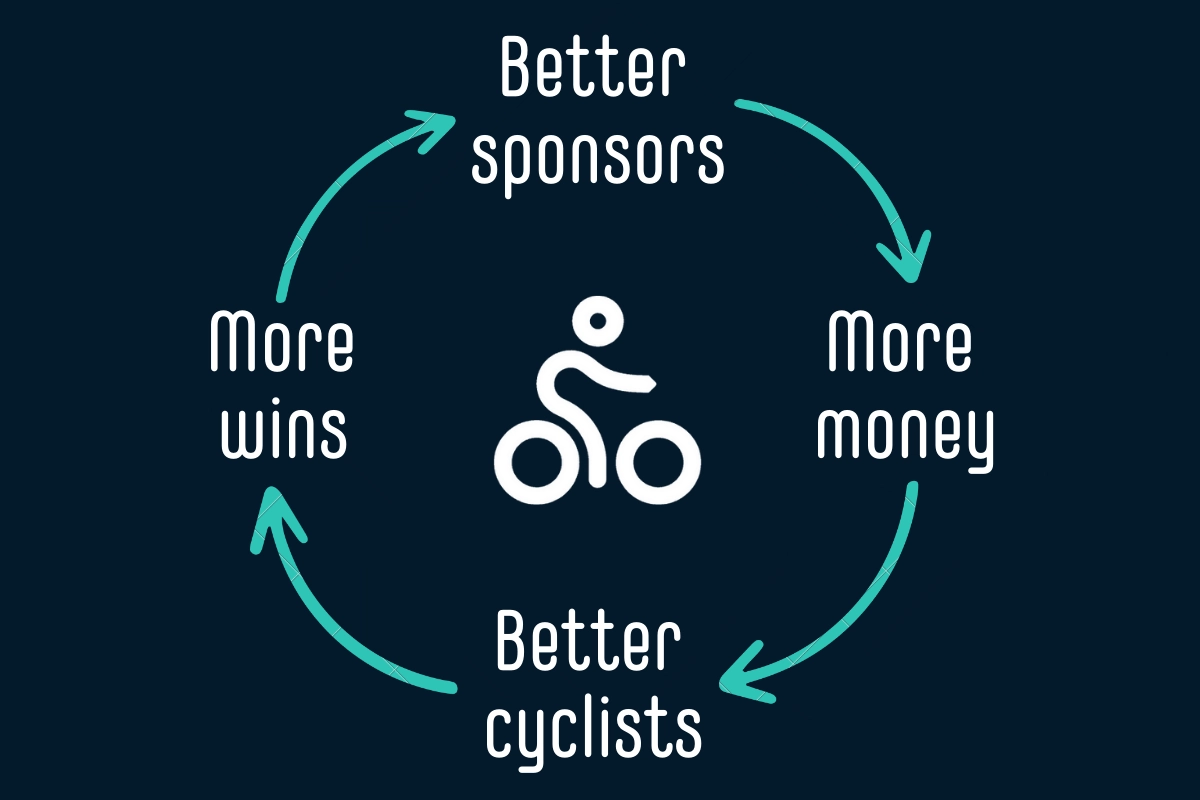Ineos Grenadiers, Jumbo-Visma and Lidl-Trek might sound familiar but don’t get used to them as they might change soon. Cycling teams are no strangers to changing their names, all in the interest of making more money.
The cycling teams’ names are composed of the sponsors’ names, which are the teams’ main source of income. As the position of the name sponsor is worth the most money, teams accept constant renaming, even if this makes it harder for them to create an identity that fans can connect with.
Let’s dive deeper into the weirdness of teams’ names and the driving force behind them.
Why don’t cycling teams get real names?
We are used to teams in popular sports having established names that they have been using since their founding. We can’t imagine Los Angeles Lakers or Real Madrid being named differently.
Well, you can’t get attached to a team name in cycling, as it will probably change in a few seasons. You need to be attached to the organization and the cyclists, while the name is only a minor detail.
Cycling teams do not have a permanent name because they follow a different financial structure than most sports teams.
It’s important to understand that teams don’t get money from tickets as races take place on public roads. They also don’t get the money from TV rights, which belongs to the race organizer. So, their only income to cover cyclists’ wages and other expenses is sponsorships and prize money.

Sponsorships represent the majority of income. Teams are desperate to get as much money from them as possible, so they offer the sponsors everything they can – including name rights.
Selling team name rights can be compared to selling stadium name rights, which is more common in other sports.
Of course, teams also raise money in other ways or try to lower their costs through gear sponsorships. In exchange for money, sponsors can put their logos on the riders’ jerseys, which act as moving billboards.
However, a name sponsor’s place is worth the most. Teams try to sell it to multiple companies to increase their budget. And that’s how we get names such as Serramenti PVC Diquigiovanni Androni Giocattoli. Yes, it can be that awful.
How often do teams change their names?
Different teams change their names with different frequency.
A few teams have had the same name (and the same sponsor) for many years. French team Cofidis is one of them, using the same name from its creation in 1997. Spanish team Movistar also uses the same name since 2011. But these are exceptions rather than the rule.
Generally, smaller teams switch their names more often as they struggle to get long-term sponsorships. Bigger and more established teams are more attractive to bigger companies that easily commit to multiyear sponsorships.
As a rule of thumb, smaller teams change their names every 3-5 years, while larger teams stick with the same name for around 10 years.
Usually, name changes only partially, as only one sponsor changes while the others remain. This gives us examples, such as the renaming of Alpecin-Fenix to Alpecin-Deceuninck.
And this is where additional confusion can arise.
Some companies love being associated with cycling and have been sponsoring teams for decades. Sponsorships are all about brand awareness, and the easiest way to do that is to sponsor a winning team.
Keeping track of team name changes can cause a lot of confusion.
The winning teams tend to change over time, so the sponsors also switch the teams they give money to. So, part of one team’s name can be changed, and the company’s name becomes part of another team’s name.
We could see such an example recently when Soudal changed the sponsorship of a team. So Lotto Soudal lost its sponsorship, and the other Belgian team suddenly became Soudal-Quick Step.
How much is a name sponsor position worth?
Getting a name sponsor is not an easy task, especially a sponsor willing to pay big bucks to be used in a team’s name.
The name sponsor position isn’t cheap. Sure, the price depends on the size of the team and the number of name sponsors, but on average, teams charge 10-15 million euros ($11-16M) for a naming sponsor position.

Due to the high pricing, sponsors and, consequently, team names change so quickly. There aren’t many companies that can justify spending such amounts on sponsorships.
So when the times are tough, and companies need to cut their spending, the cycling team sponsorship is one of the first things they cross off.
If a team fails to find a replacement in time after the sponsor’s exit, the team will fold. Every few years, we see some of the smaller teams wave goodbye, and a new team takes its place. The laws of nature also apply to cycling.
Branding attempts of cycling teams
As we already established, it’s hard for cycling teams to create some sort of identity if they change the name every few seasons.
This is why more and more teams want to present themselves with a separate narrative and a nickname that moves away from the team name and remains the same regardless of what the team name is.
Probably the most successful branding attempt was made by the Soudal-Quick Step team, who chose “The Wolfpack” as their nickname. It has no connection to the team name, but everybody knows who we are talking about when we talk about “The Wolfpack.”
This kind of branding success also brings certain financial benefits. Every year, the team sells a lot of merchandise with their nickname, wolf’s head or other motifs printed on it, primarily reflecting the nickname rather than the team name.
Another quite successful example of branding was achieved by Bora-hansgrohe. The German team has adopted the nickname “Band of Brothers,” which also easily withstands any changes to the team’s name.

